Breaking Barriers: Wonder Woman and the Bold Women of Medicine, a guest post by Susan M. Latta
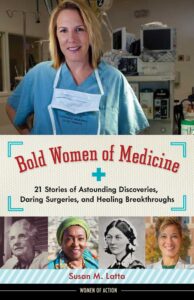 Wonder Woman is a strong female comic book character but there is more to her than muscle. She boldly and intelligently outsmarted her enemies. When Warner Bros./DC Comics blockbuster movie Wonder Woman came out earlier this summer I began to think about the characteristics shared between Wonder Woman and the women in my YA nonfiction book Bold Women of Medicine: 21 Stories of Astounding Discoveries, Daring Surgeries, and Healing Breakthroughs, Chicago Review Press. (For Amanda’s review of this title, please pop on over here.)
Wonder Woman is a strong female comic book character but there is more to her than muscle. She boldly and intelligently outsmarted her enemies. When Warner Bros./DC Comics blockbuster movie Wonder Woman came out earlier this summer I began to think about the characteristics shared between Wonder Woman and the women in my YA nonfiction book Bold Women of Medicine: 21 Stories of Astounding Discoveries, Daring Surgeries, and Healing Breakthroughs, Chicago Review Press. (For Amanda’s review of this title, please pop on over here.)
Wonder Woman and the Bold Women of Medicine were controversial when they first appeared and remain so today. They were both unrestrained by the social norms of the era. The women medical pioneers weren’t supposed to be interested in science or medicine; many men and women considered these subjects much too advanced or gruesome for a woman. The treatments medical women perfected; whether it was Sister Elizabeth Kenny’s polio treatment, or Helen Taussig’s research in treating babies with serious heart defects, or Virginia Apgar’s assessment of newborn health, all proved that women could and did have a stake in medicine.
ADVERTISEMENT
ADVERTISEMENT
In 1939, Superman starred in the first comic book to showcase just one character, followed by Batman later that same year. And in 1941, Wonder Woman, an Amazon who hailed from an island of women only “came to the United States to fight for peace, justice, and women’s rights.”[i] Much like Batman and Superman, Wonder Woman also had a secret identity as a shy secretary named Diana Prince. But as Wonder Woman, she was resilient. And what more could the world want than a strong female character that still possessed tenderness and compassion.
William Moulton Marston, a trained psychologist, expert in lie detection, and a man influenced by several strong women including Margaret Sanger, (who heavily influenced the comic book character) created Wonder Woman. He was raised by strong women and predicted that one day women would rule the world.
The original inspiration behind Wonder Woman was women’s fight for equal rights. Marston believed that a woman must break the “chains” and free herself. And the same went for Wonder Woman except that if she didn’t use her power for the greater good, she’d be forced to return to weakness (and chains).
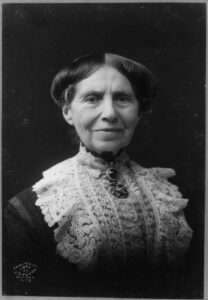
Wonder Woman was more than just a comic when she first appeared, included in each issue was a feature titled, “Wonder Women of History.” This insert heralded a real life heroic woman who possessed the same Wonder Woman qualities of “daring, strength, and ingenuity,” that in the early 1940s, qualities that were not usually attributed to women. Incidentally, Florence Nightingale was the first “Wonder Woman of History,” followed by Clara Barton, and Elizabeth Blackwell, all three of which I profiled in my book Bold Women of Medicine.
The bold women of medicine displayed strength in the ways they pursued science and medicine. Many of the medical pioneers shied away from the tenderness Wonder Woman exposed, and in that way, they are different. When women first entered the male-dominated medical world, they felt they had to be void of emotion because they believed that was the only way they would succeed.
![Mary E. Walker in Dress Pants Uniform [Credit] Wikimedia Commons](https://teenlibrariantoolbox.com/wp-content/uploads/2017/09/06-002-Caption-Mary-E.-Walker-in-Dress-Pants-Uniform-Credit-Wikimedia-Commons-182x300.jpg)
Mary Edwards Walker, a civil war surgeon, refused to be constricted by clothing traditions of the 1800s. She donned pants, covered by a long coat-like dress. Mary didn’t care what others thought of her; she only wanted to serve. She was the only woman ever to be awarded the Congressional Medal of Honor, which in fact was stripped from her shortly before she died because she didn’t meet the combat qualifications. The medal was restored to her posthumously in 1977 by President Jimmy Carter.
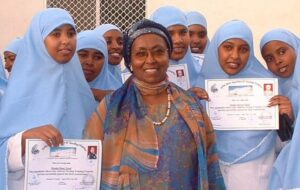
Like Wonder Woman, many of the Bold Women of Medicine do practice both the rigors of science and the art of compassion. Dr. Catherine Hamlin and Midwife Edna Adan Ismail, both still practicing, see women being mistreated every day and do their utmost to both stop the abuse and heal with surgery and care. Dr. Sister Anne Brooks, an osteopathic physician who is also a nun, before her recent retirement, fought illness with both touch and tough love. She provided education to the poverty-stricken citizens of Tutwiler, Mississippi so that they could return to good health. But if they didn’t comply, her blatant question was “to ask them if they’ve bought their coffin yet.”
ADVERTISEMENT
ADVERTISEMENT
![Bertha Van Hoosen, 1948.[Credit]Rochester Hills Museum at Van Hoosen Farm](https://teenlibrariantoolbox.com/wp-content/uploads/2017/09/07-002CaptionBertha-Van-Hoosen-1948.CreditRochester-Hills-Museum-at-Van-Hoosen-Farm-233x300.jpg)
As I researched these women, I found that perseverance was a common trait. Yes, they were smart and well educated but they never gave up. Every one of them fought or still fights insurmountable odds, and that is what I admire most about them. Even today there are ongoing challenges for women in medicine, especially in terms of wages. The 2016 Medscape Physician Compensation Report states that overall, women physicians make 24 percent less than their male peers.
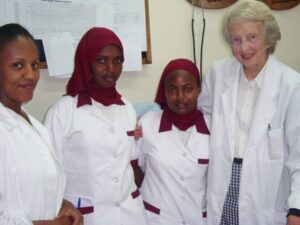
Each new generation of women in medicine leads the way, encouraging more women to choose work in a health-care field. The bold women of medicine don’t have Wonder Woman’s special powers, but they work diligently to become today’s real-life wonder women.
[i] Lepore, Jill. The Secret History of Wonder Woman. New York: Vintage Books, A Division of Penguin Random House, 2014, Introduction.
Meet Susan M. Latta
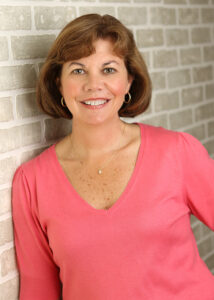
Susan Latta earned a bachelor’s degree in journalism and Mass Communications from Iowa State University and her masters in business administration from Drake University. She has worked in several fields including advertising for a large agency in St. Louis, Missouri, and in marketing and finance for the family business, McGarvey Coffee in Minneapolis, Minnesota. She earned a master of fine arts in writing for children and young adults from Hamline University. In addition to Bold Women of Medicine, Susan has written on history, biography, and geography for Appleseeds and Faces magazines and completed freelance work for Heinemann Leveled Books and ABDO Publishing. Susan has three adult children and lives with her husband and two Golden Retrievers in Edina, Minnesota.
Connect with Susan online:
Twitter @lattasusan, Instagram suslat, Facebook Susan McGarvey Latta
Filed under: Uncategorized
About Amanda MacGregor
Amanda MacGregor works in an elementary library, loves dogs, and can be found on Twitter @CiteSomething.
ADVERTISEMENT
ADVERTISEMENT
SLJ Blog Network
2024 Books from Coretta Scott King Winners
The Ultimate Love Letter to the King of Fruits: We’re Talking Mango Memories with Sita Singh
Double Booking | This Week’s Comics
Parsing Religion in Public Schools
ADVERTISEMENT







